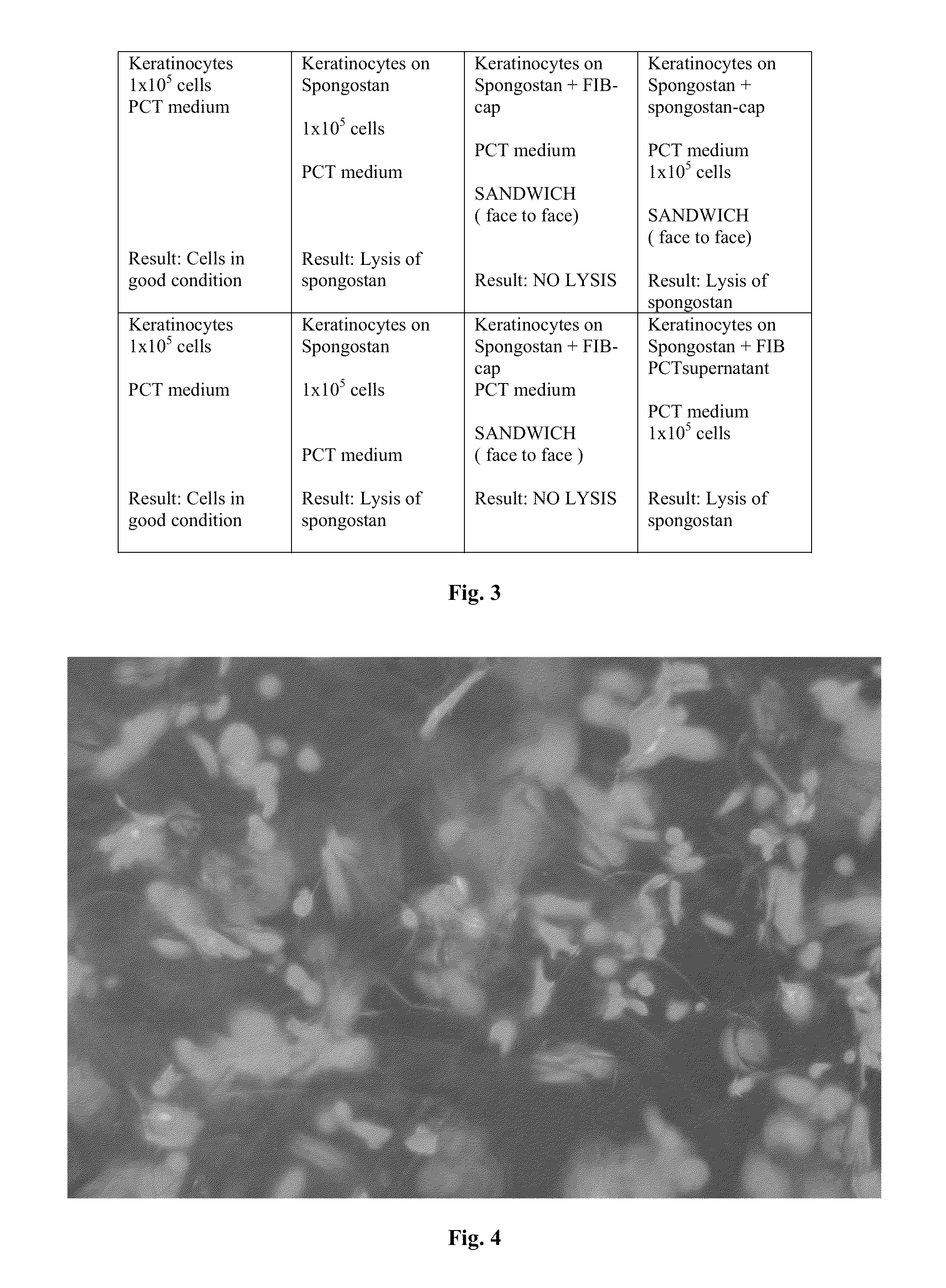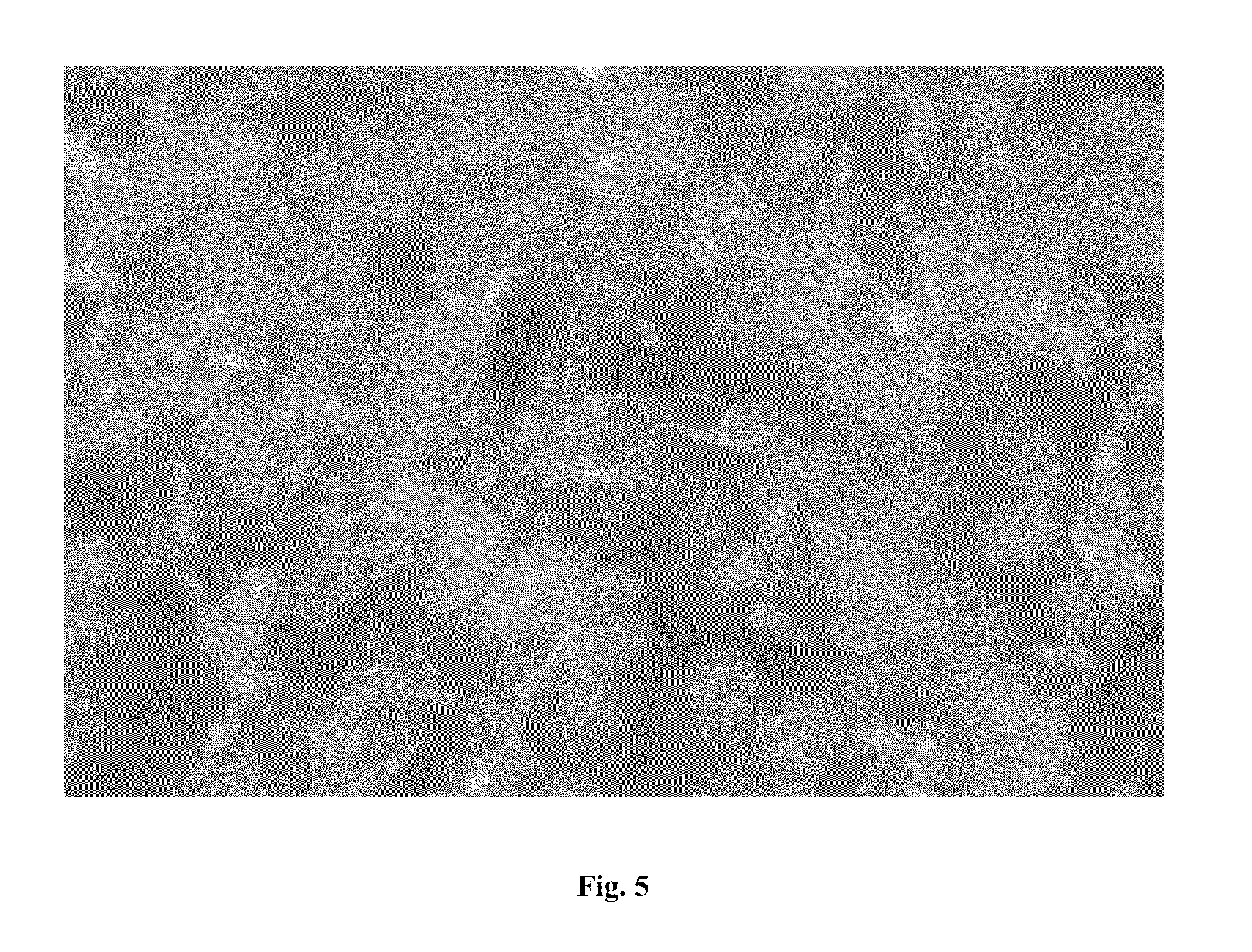Cellular scaffold
a cell and tissue technology, applied in the field of tissue engineering, can solve the problems of fibroblast culture, clear undesirable effects, and a challenge to the production of therapeutic tissue models
- Summary
- Abstract
- Description
- Claims
- Application Information
AI Technical Summary
Benefits of technology
Problems solved by technology
Method used
Image
Examples
example 1
Equipment and Material
[0174]Laminar flow hood[0175]CO2 incubator[0176]Inverted microscope[0177]PCT medium (Progenitor Cell Targeting Medium) (Cat#CnT-07, Chemicon)[0178]Epidermal Keratinocyte Medium (Cat#CnT-02,Chemicon)[0179]1M Calcium Chloride (CaCl2) (Cat#SH30289.01, Lot #NAQS24 656, HyClone)[0180]Dermal Fibroblasts Medium (Cat#CnT-05, Chemicon)[0181]PBS (Ca-free) (Lot#1332722, Cat #20012,Gibco)[0182]Hank's solution Ca-free (Lot#1326012, Cat#14170,Gibco)[0183]0.25% Trypsin-0.5 mM EDTA solution (Lot#1329679,Cat#252000-106 Invitrogen.Inc)[0184]Trypan blue solution (Lot #36K2353, Cat. 18154, Sigma)[0185]12, 24-well plates[0186]Culture flask, 25 cm2 [0187]15, 50 ml sterile plastic tubes[0188]Spongostan (Johnson@Johnson)[0189]Live / Dead Viability / Cytotoxicity Kit:[0190]Caleein AM (component A), two vials, 40 μl each, 4 mM in anhydrous DMSO, Ethidium Homodimer-1 (component B), two vials, 200 μl each, 2 mM in DMSO / H2O 1:4 (v / v) (Molecular Probes Invitrogen detection technologies).
example 2
Primary Cell Culture
[0191]An abdominal skin biopsy from a 44-45 year old Hispanic female was washed 10 times in 100 ml of Gentamicin solution in Ca-free PBS. The washed skin was trimmed to remove the fat and to expose the dermal layer. The trimmed skin was cut with scissors on pieces 3 mm thick and 3 cm long. The pieces were washed 3 times in 30 ml of Gentamicin solution in Ca-free PBS. The washed pieces were incubated in 0.125% Dispase solution in Ca-free PBS for 18 hr at +4 C. Following the incubation the epidermis was peeled off by forceps and placed in Ca-free PBS. The isolated epidermis was digested in 0.125% Trypsin-0.53 mM EDTA solution for 3 min in the water bath at 37 C. The digestion was stopped with ×2 amount of 1% human albumin solution RPMI-1640 culture medium. The cell suspension was filtered through 200μ a nylon mesh, centrifuged, resuspended in Ca-free Hank's solution and the cell count was determined.
[0192]The cells were centrifuged again, resuspended in Keratinocyt...
example 3
Preparation of Spongostan for Fibroblast Seeding
[0193]1. Cut a circle from Spongostan film 2.5 cm in diameter.[0194]2. Put circle of Spongostan into a well of the 24-well plate.[0195]3. Add 500 μl of Dermal Fibroblasts Medium (Cat#CnT-05, Chemicon) to well with Spongostan to prepare for cell culturing in CnT-05 medium[0196]4. Place 24-well plate in a 37 C, CO2 incubator for 30 minutes.[0197]5. Remove 24-well plate from an incubator.[0198]6. Remove the medium from the well.[0199]7. Add 500 μl of CnT-05 medium to a well with Spongostan.[0200]8. Place 24-well plate in a 37 C, CO2 incubator for 30 minutes[0201]9. Repeat 3-8 steps (washing) 2 times.
PUM
 Login to View More
Login to View More Abstract
Description
Claims
Application Information
 Login to View More
Login to View More - R&D
- Intellectual Property
- Life Sciences
- Materials
- Tech Scout
- Unparalleled Data Quality
- Higher Quality Content
- 60% Fewer Hallucinations
Browse by: Latest US Patents, China's latest patents, Technical Efficacy Thesaurus, Application Domain, Technology Topic, Popular Technical Reports.
© 2025 PatSnap. All rights reserved.Legal|Privacy policy|Modern Slavery Act Transparency Statement|Sitemap|About US| Contact US: help@patsnap.com



